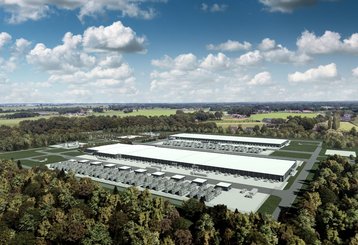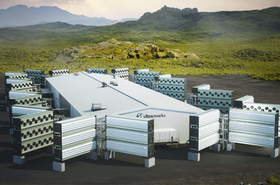Meta is developing its own direct air capture (DAC) technology that it hopes to scale across its global data center fleet.
At the same time, X Development (the Alphabet subsidiary, not the social media platform) has sought to patent its own data center DAC project.
Both use data center waste heat. Neither effort has been previously reported on.
Meta began work on its DAC efforts around 2021, employee posts on LinkedIn reveal. The project appears to have started with senior engineer Adam Dovell, who "designed, built, and operated a benchscale prototype of a Carbon Removal technology integrated into data center cooling systems," and presented it to Meta CTO Andrew Bosworth.
From there, the project moved to principal project manager Patrick Louis, who "prototyped liquid direct air capture solution using data center heat for sorbent regeneration."
Subject matter expert Eshan Singh was brought in last year, where "he built a model for equilibrium and rate-based calculations for CO2 capture and regeneration with liquid sorbents" and worked with undisclosed academic partners for evaluating solid-sorbents.
A sorbent is a material that either absorbs or adsorbs liquids or gases - in this case carbon dioxide (or just carbon). Once the sorbent captures the CO2 from the air, it is then heated to just release the carbon, which can then be stored elsewhere.
Singh also "modeled changes in water consumption with full liquid DAC-integration, and how it varies with different sorbents."
Singh left later that year, and the effort now appears to be led by Julius Kusuma, who says he is developing "a novel Direct Air Capture (DAC) system that leverages low-grade waste heat and air flow in data centers. If we succeed, we will be able to capture carbon at significantly lower cost than standalone DAC."
Meta declined to comment on the effort but confirmed the project.
Less is known about X Development's project. The company has applied for a patent that "describes methods and systems for producing carbon dioxide captured in a DAC process with waste heat from an industrial process.
"In some aspects, waste heat from an industrial process, such as heat derived or generated from a data center, is used in combination with one or more heat pump assemblies to separate the captured carbon dioxide from a solid or liquid material in which it is entrained (e.g., by breaking bonds between the carbon dioxide and the solid or liquid with the heat)."
The patent was published in 2023 but filed back in 2021.
The company did not respond to requests for comment, and it is not clear if the research effort is still underway. Bryan GilroySmith, one of the names listed on the patent, has since left to work at Amazon. Microsoft has also filed a patent for a “carbon capture system" using data center waste heat.
X also has a DAC 'moonshot' that was spun off into its own company, 280earth, which is building a carbon capture facility in The Dalles, Oregon - just a few hundred meters from a Google data center. The company says that it can use "low-grade waste heat from nearby industrial facilities."
Data center waste heat has been reused for everything from lobster farms to growing eels, and heating swimming pools. But there are those that, like Meta and X, hope to use it to capture carbon.
One challenge has long been that most sorbent approaches require high temperatures to release the carbon - which, in turn, requires a huge amount of power that can have its own carbon footprint. Last year, startup Spiritus came out of stealth with a sorbent that can use low-grade heat.
"A key for Spiritus is that we can use <100℃ [212ºF] heat, which provides large advantages because we don't have to use energy to create steam (i.e. no boiling water needed)," Mindy Ren, head of carbon removal infrastructure at Spiritus, told DCD.
Ren - who joined the company from Meta's data center operations - said that data centers represent "a key customer set for Spiritus."
However, "a key challenge for utilizing waste heat from data centers is where to sequester (store) the carbon that is captured." One could either store it in underground formations or in underground mineralization in basalts (as Climeworks does in Iceland).
"These underground formations are in specific locations (the US Mountain West to the Gulf of Mexico, and in the Pacific Northwest)," Ren said. "Therefore, you need to either have your data center at one of these locations or develop a pipeline to transport the CO2 to the desired location. Transport poses key risks to permit."
This, the company said, means that "it may only be applicable for specific [data center] locations at scale," while other operators may just pay for DAC at a non-data center site to offset their own emissions - potentially allowing hyperscalers to build in locations where they cannot get renewable power.
According to Spiritus' calculations, it generally becomes worth installing a DAC on data centers with 20-50MW of waste heat, while "data center campuses that generate 300MW of heat are sufficient to support a three megaton per year Spiritus Carbon Orchard vs only one megaton per year for previous generation DAC technologies."
Its referenced Orchard One project - the company's first, and not set at a data center - will remove two million tons of CO2 from the air annually, Spiritus claimed.
The company declined to say if it was involved in either project with Meta and X.
"Since our DAC operates continuously, a data center with 24/7 waste heat dissipation is ideal for ensuring synchronized operation of both systems," Ren said.
Google parent Alphabet, along with Meta, are both part of Frontier Climate – which makes aggregated purchases of carbon capture credits from a number of companies' projects and technologies, including DAC.
Frontier has invested in projects from the likes of Lithos, CarbonCapture Inc., Heirloom, Airhive, Inplanet, and Living Carbon.
Google, which has invested $35 million into carbon capture projects, said it had made “recent purchases” through Frontier, but hasn't provided details.









